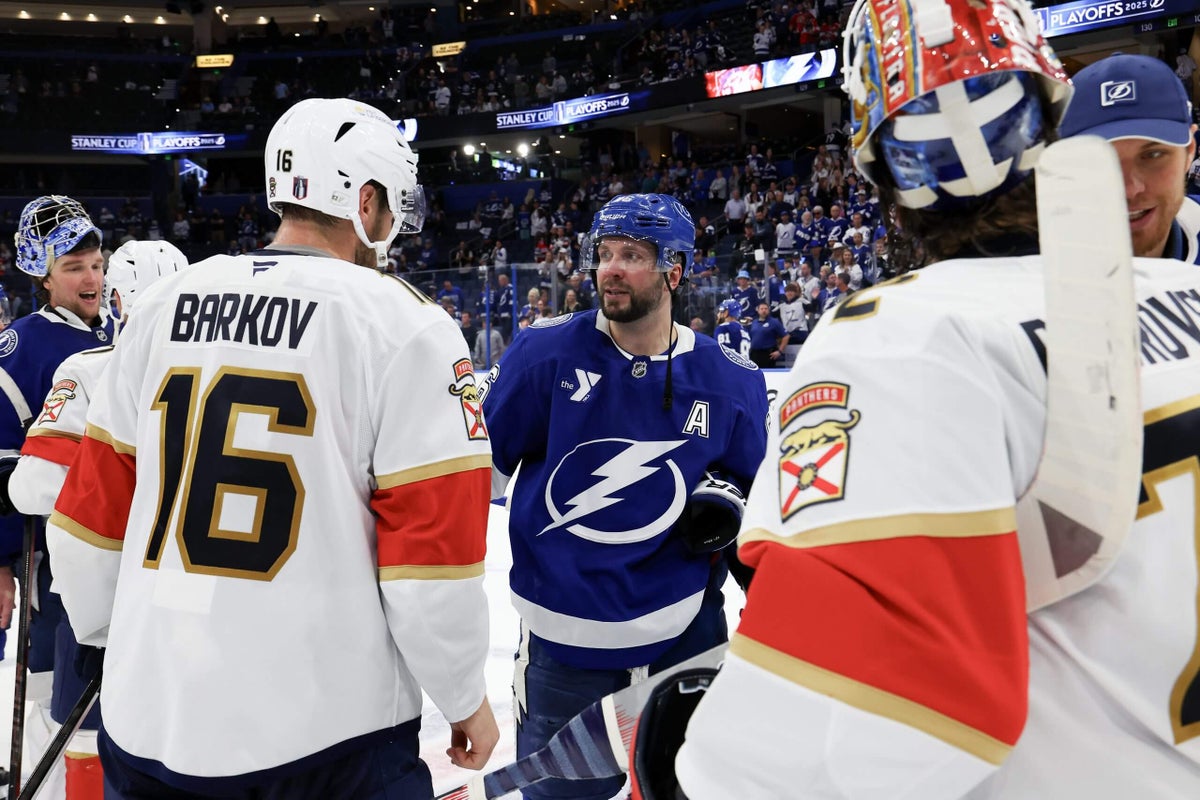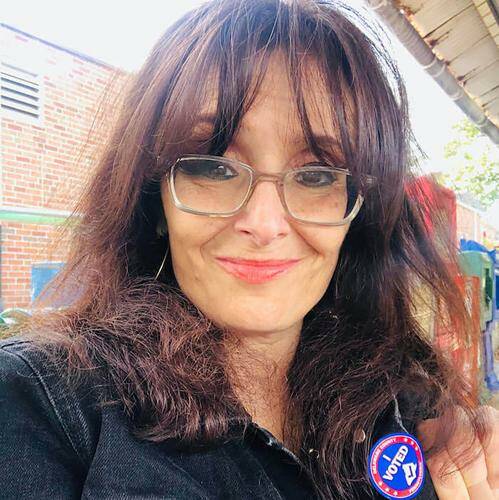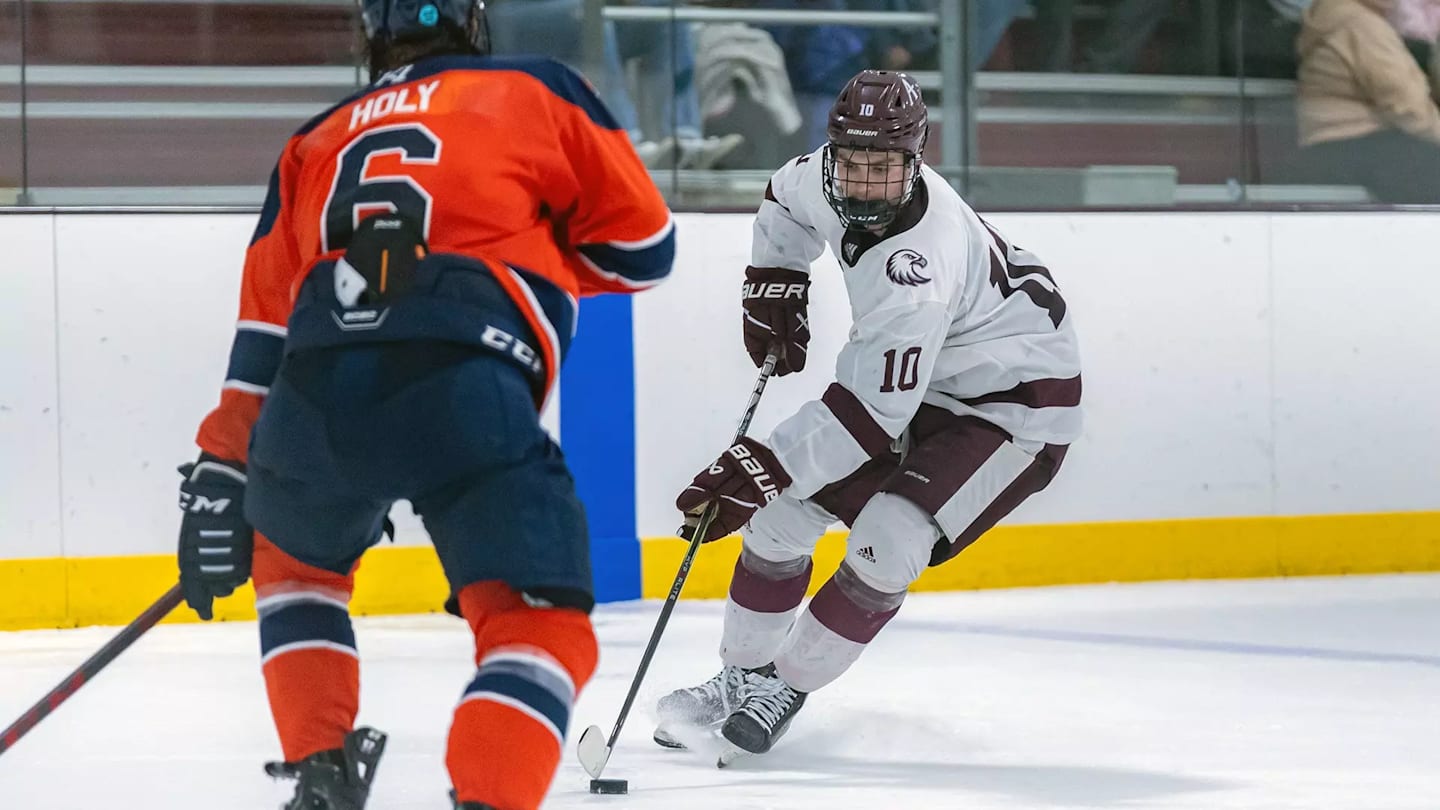Mike Rupp wishes he had a time machine.
The former NHL player and Stanley Cup champion would love to see how the Tampa Bay Lightning’s championship teams from 2020 to ’22 would do against this current run of the Florida Panthers. The Panthers are in their third straight Stanley Cup Final, starting Wednesday, following three in a row by Tampa Bay, which won the title twice.
Who would win?
“I have no idea,” Rupp said, “It’s that close.”
“It would go seven games and probably into OT,” said former NHL coach Rick Bowness.
“Tough to call,” Nashville Predators general manager Barry Trotz said. “It would be nasty, though.”
Part of what makes imagining it so fun is that there’s a similar feel to the dominant runs made by the Lightning and Panthers.
Minnesota has called itself the “State of Hockey” since the Wild trademarked the phrase soon after their 2000 inception. But let’s be honest: When it comes to NHL playoff success, the actual “State of Hockey” has become Florida, with no signs of that slowing down.
The Panthers and Lightning have won three Stanley Cups in the past five years and 22 playoff rounds in the past six. Since the start of the 2020 playoffs, Tampa Bay (52) and Florida (48) own the first- and second-most playoff wins in the NHL. And for the “they don’t care about hockey in Florida” crowd, both teams played at virtually 100 percent capacity this regular season, and the state of Florida saw a 73 percent increase in youth hockey participation from 2012 to ’24, according to USA Hockey.
From the star power to goaltending to difference-making third lines, the Lightning and Panthers Cup teams can be seen as mirror images.
And that was by design.
“I had the benefit of those Tampa teams existing when we got here,” said Panthers general manager Bill Zito, hired in 2020 after being the Columbus Blue Jackets’ assistant GM. “I watched how Julien BriseBois did it. Winning against them when I was in Columbus (in 2019). Losing to them when I was in Columbus in the (2020) bubble, I got to watch a lot of their team and how it was assembled. There was almost like a blueprint, and by the way, they’re right down the road.”
Zito said BriseBois, was extremely “gracious” with his time and offered guidance after he landed the job on the other side of the state, and he used how the Lightning were built as a “model.”
“It would probably be a little pretentious of me to sit here and say they followed our blueprint,” coach Jon Cooper said. “But yes, there are parallels.”
Whether the Panthers can match the Lightning’s title count remains to be seen. If they do, it’d put them in similar rare air to Cooper’s group.
“Tampa, for me, surpassed Chicago, Pittsburgh, L.A., as far as being like the modern-day dynasty,” Rupp said. “I don’t know if I used that word too lightly or loosely, but I think what we’re seeing from Florida right now, they’re on the precipice of potentially taking that over.”
Now, Florida takes no state income taxes out of paychecks — a huge talking point when it comes to the Lightning and Panthers’ runs. The Vegas Golden Knights, Dallas Stars, Nashville Predators and Seattle Kraken also play in no-state-income-tax states, which many point to as an unfair advantage especially in Canada and high-tax states like California, New York/New Jersey and Minnesota. (According to league sources, in the new collective bargaining agreement that’s close to being agreed upon, there won’t be any new provisions addressing the situation.)
There are other benefits to playing in Florida, too, from living on the water and driving to practice in golf carts, but that’s been the same since each team entered the league.
“The majority of players in any era would want to be here regardless — taking the lifestyle out of it, taking the tax breaks out of it — but especially now in the run that they’ve each had,” TNT analyst Ed Olczyk said. “You want to make as much money as you can as a player, but mostly, you want to win.
“This is a destination now because they win. Each of these teams is a place you’d look to go because they’re going to do whatever it takes to win.”
So how did they create that winning culture?
Whatever advantages they have, for much of their histories, these teams have struggled — with the Panthers going from 1997 to 2022 without winning a playoff round. What was the “blueprint” for going from doormats to borderline dynasties?
Versatile and relentless styles
The systems aren’t necessarily identical, and that doesn’t really matter.
Trotz said the Panthers are a “true forecheck team,” and while those Lightning teams did damage on the forecheck, “they were still a very good rush team.”
What stands out as comparable is their versatility and relentlessness. Bowness was a long-time Lightning assistant but got a whole new appreciation after losing to them with the Stars in the 2020 Cup Final.
“Both teams can play any style you want,” Bowness said. “You want to play physical? We’ll play physical. You want to play fast? We can play fast. You want to play high-skilled? We can play high-skilled. Those are the ingredients to be able to win games, too. You can play any style you want. They got some nasty players on both of those teams. That’s how you win in the playoffs.”
Brian Boucher, an analyst for TNT, said Florida’s style is more “smashmouth hockey.”
“Tampa wasn’t like that,” Boucher said. “Tampa had the skill but had an identity line, and they played the game differently. These guys, though, they play the game old-school. … For a lack of a better term, they’re bullies. They’re bullies, but with skill.”
Third lines
The most important similarity between the two teams, according to former GM Craig Button, is their “identity” third lines.
The Barclay Goodrow-Yanni Gourde-Blake Coleman line was the X-factor for Tampa Bay’s back-to-back Cup wins, providing defense and clutch scoring. The same holds true for this year’s Panthers, with Brad Marchand-Anton Lundell-Eetu Luostarinen.
“They’re more skilled than you realize,” Bowness said. “They (don’t) just score, but they’re also agitators. They get in your face, they don’t back off, they don’t get looked off on the forecheck. … They’re fast, and they’re just very hard to play against because you don’t get a lot of time. You know you’re going to get hit.”
The lines also both came together on the fly. The Gourde line wasn’t put together right away after Goodrow and Coleman were acquired in 2020. Marchand was added at this past year’s deadline.
“I’d love to see the Gourde-Coleman-Goodrow line versus the Marchand line,” Rupp said. “Oh my god, I’d pay money for that. That’s crazy because they’re so alike.”
Star power
It starts with the captains and two of the game’s consummate pros: Steven Stamkos and Aleksander Barkov.
“I say to my son, ‘I hope you can be as good a guy as Sasha,’” Zito said. “He makes you want to be a better person, a better teammate, the kindness that he shows, the way he treats every single person he comes across.”
Stamkos, the 2008 No. 1 pick, took the hard road to finally lifting the Cup and is regarded as one of the best captains in league history. Tampa Bay also doesn’t win the two titles without Nikita Kucherov’s ascent and dominant runs in 2020 and 2021. Brayden Point was a Conn Smythe contender both years after being a middle-round steal.
The stars for both teams also take care of the defensive side of the puck. Sam Reinhart is a Selke Trophy finalist this year, and Barkov is a two-time winner and one of the best two-way centers in the NHL. Since the start of the 2024 playoffs, Barkov has only been on the ice for four even-strength goals against (excluding empty-netters) in 41 games. He never cheats the game, and when it comes to big moments like his monster assist on Carter Verhaeghe’s winning goal to close out last week’s Eastern Conference final, he’s got the ability to come through offensively. Plus, he has 25 career playoff goals.
Then you add in Verhaeghe (the Panthers’ career playoff leader with 32 goals, including three series clinchers), who won a Stanley Cup with the Lightning in 2020, Reinhart (25 goals), Sam Bennett (24 goals) and Matthew Tkachuk (22), and the Panthers have shown they can stick with anybody offensively.
“We know what’s going on in Tampa with Point, Kucherov and all the changeover there, but they’ve always had consistent stars,” said Olczyk. “They do it a little different way in Florida. I mean, Reinhart, all he needs is one or two chances to score a goal. Barkov is as complete a player as there is. Verhaeghe’s as clutch a player as there is. Tkachuk and Bennett can score and punish you.”
Blue lines
When Trotz was preparing the Islanders to face the Lightning in 2020 and 2021, his focus wasn’t necessarily on stopping Tampa Bay’s forwards. It was somehow fighting through Tampa Bay’s towering blue line.
There was three-time Norris Trophy finalist Victor Hedman (6-foot-7), Erik Cernak (6-4), Ryan McDonagh (6-2), Mikhail Sergachev (6-3) and Luke Schenn (6-2).
“As much as everybody talked about Point and Kucherov and all their forwards, we knew if we played solid team defense, we could limit them,” Trotz said. “But we talked more about how the hell are we going to get through that forest of trees?”
The Panthers have some size as well, with Aaron Ekblad (6-4) and trading for Seth Jones (6-4) this year. Gustav Forsling is only 6-1 but has become one of the best defensive defensemen in the NHL, while Niko Mikkola’s star is rising — a well-rounded blueliner who is 6-foot-5 but can also fly.
The Panthers have had to shuffle guys in and out the past three years because of the cap, losing solid defenders like Brandon Montour and Radko Gudas. This postseason, Dmitry Kulikov and Nate Schmidt have done a terrific job on the third pair.
Olczyk said the Lightning and Panthers’ real connection is the back end.
“When you look at the size, you look at the mobility, you look at the difference makers and the depth, it’s just not one to 3 ½. It’s one to six,” Olczyk said.
Goaltending
As good of a job as Zito has done in South Florida, he credits predecessor Dale Tallon for building blocks like Barkov and Sergei Bobrovsky.
Bobrovsky had a tough start to his Florida career, but Zito knew him from Columbus — knew his commitment and unparalleled process — and felt when he got the Panthers job that goaltending would be the least of his concerns.
In three postseasons, Bobrovsky is 40-19 for Florida with a 2.41 goals-against average and .911 save percentage.
Andrei Vasilevskiy, meanwhile, had NHL greats already saying he was putting himself onto “Mount Rushmore” among top goalies, and his 2021 Conn Smythe trophy was well deserved: 1.90 GAA, .937 save percentage, five shutouts. He ended five straight series with a shutout from the 2020 Cup Final through the 2021 Cup Final.
Bobrovsky was a Vezina Trophy finalist last year, while Vasilevskiy, who won the Vezina in 2019, was also a finalist in 2020.
Comparing the stars
The top players on the Lightning and Panthers Cup runs, by net rating:

Coaching
Cooper, the longest-tenured coach in the NHL, has coached around 1,000 fewer games than Paul Maurice but is considered by many to be the standard in the league. He was the third-fastest coach to 500 wins in NHL history.
Both coaches are also great quotes, strong motivators and collaborative with their assistants and strong game managers.
Before last year, Maurice had coached the most games in NHL history without winning a Stanley Cup. Now he’s one of four coaches to have made the Stanley Cup Final in each of his first three seasons with a franchise, along with Toe Blake (five, Montreal Canadiens, 1956 to 1960), Scotty Bowman (three, St. Louis Blues, 1968 to 1970) and Tommy Ivan (three, Detroit Red Wings, 1948 to 1950).
He’s also one of two coaches to win 10 series in his first three seasons with a franchise (Darryl Sutter, Los Angeles Kings, 2012 to 2014).
“Paul and Coop both do a great job preparing their team and any adjustments that are made during the series,” Bowness said. “They’re both very good at that.”
Management and ownership
Back in 2010, Lightning CEO Steve Griggs said the brand was “dead.” The season ticket base was down to around 4,500. They had missed the playoffs for three straight years.
But when Jeff Vinik bought the team that summer, it started the transformation. He hired Steve Yzerman as GM, who helped build those Cup teams before leaving for Detroit in 2019. BriseBois, Yzerman’s long-time right-hand man, has been bold and decisive in continuing to build the contender — and keep it together through a COVID-19-sparked flat cap.
Unstable ownership plagued the Panthers after original owner Wayne Huizenga sold the team in 2001, but that dissipated when Vinnie Viola bought the franchise 12 years ago and especially when he hired Zito as GM during the pandemic.
Zito has made huge acquisitions, including Tkachuk, Bennett, Reinhart, Jones, Marchand, Forsling, Mikkola and Evan Rodrigues. He fills holes when the cap costs the Panthers a player like Montour and even had the guts to fire Andrew Brunette after winning the Presidents’ Trophy in 2022.
Viola spares no expense, from a state-of-the-art practice facility to off-ice perks for players to allowing Zito and his large front office to think outside the box and do their thing.
“It’s empowering that we’re able to conduct our business without fear and knowing we have their full support,” Zito said.
Zito said one thing Tampa Bay showed him was not to be afraid of trading draft picks. BriseBois traded a first-round pick in each of his deals for Coleman and Goodrow at the 2020 deadline, for example.
“We had this decade of losing, but we have this window now, but we’re also trying to continue to perform, continue to win, continue to grow, continue to get interest, continue to grow in our community,” Zito said.
So who would win: 2020-22 Lightning 0r 2023-25 Panthers?
It’s “fantasy hockey,” as Trotz calls it, to pick who was better or would win in a seven-game series.
“I’d say that Tampa had the advantage of forward, defense and goalie,” Rupp said. “But the Panthers, as far as being a junkyard-dog-mentality team from every player, there’s a way they play, a style they play, that makes it really even for me. The way they play, it’s just different. I would give all the categories in favor of Tampa, but when you ask me who would win the series, I have no idea.”
Added Zito, “There’s a lot of similarities, from up front to the back end to in goal. Behind the bench, you have very smart people. On top of being very smart hockey people, they’re also kind with great senses of humor. And then you have Julien, and as we just saw with Mathieu Darche leaving Tampa for the Islanders, solid people who you can trust.
“These two teams compete against each other, and it’s so much fun, because you want to beat them so bad and you know they want to beat us so bad, but when it’s over, we were sincerely happy when they won their Cups and I know they’re sincerely happy for us during our runs.”
The fact that the Panthers, having lost to the Lightning in back-to-back postseasons in 2021 and 2022, started to change and become more like Tampa Bay wasn’t necessarily a surprise. And now you can see the Lightning following suit, coming off three straight first-round exits (two to Florida), trying to figure out a way to beat the Panthers.
There’s a real chance the state’s streak of six straight conference titles extends through next season. And they have each other to thank.
“It’s very rare,” Trotz said. “But I think that division rivalries, when your No. 1 rival is winning Cups, it’s the best teacher. Those things rub off on each other when you want to beat the Joneses, and the Joneses live next door.”
(Photo of Aleksander Barkov, Nikita Kucherov and Sergei Bobrovsky: Mike Carlson / Getty Images)




 :
: 















 + Who will be MVP
+ Who will be MVP  Siakam over Haliburton?
Siakam over Haliburton?  | SportsCenter
| SportsCenter












































 BREAKING: NBA MVP Shai Gilgeous-Alexander signs the RICHEST annual salary in league history
BREAKING: NBA MVP Shai Gilgeous-Alexander signs the RICHEST annual salary in league history